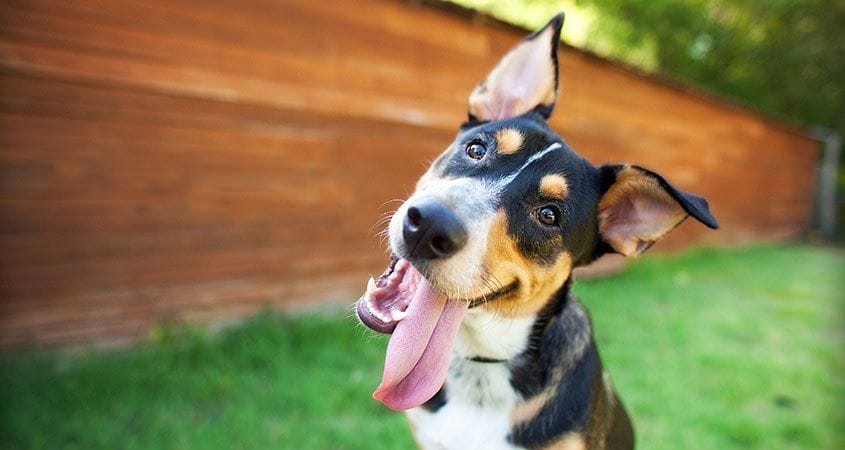If you’ve ever been around a dog, you’ve probably seen this classic of canine behavior: they tilt their head to one side while you’re talking to them, and the tilt seems to be bigger the more excited your tone of voice is.
It’s such a universal behavior in dogs that you’d think science would have figured out the cause for it a long time ago. Well, science does have an answer, which is, “We’re not really sure.”
Multiple explanations
Although dogs perceive the world through nose, eyes, and ears, in that order, a dog’s sense of smell does not enter into any of the possible explanations for the head tilt. Most ideas about it fall into either vision or hearing.
Here’s looking at you
One study that is frequently quoted was carried out, very informally, by Stanley Coren, who has a doctorate in psychology from Stanford University. His reasoning was that dogs cock their heads to one side because they like to see our entire face in order to figure out our emotions, but that their muzzles block part of the view. The tilt sideways allows them to see past their own noses.
But how to figure this out? Coren realized that dogs with “pushed-in” faces, like pugs and French bulldogs, wouldn’t have the problem with the blocked view, so they would be less likely to tilt their heads.
He surveyed 582 people, asking them to rate their dog’s head-tilting frequency on a scale from “never” to “always,” then took the “frequently,” “most of the time,” and “always” responses to indicate which dogs were more likely to tilt.
When he compared these numbers with whether the dogs had long or short muzzles, the dogs with longer muzzles were reported as likely to tilt their heads by 71% of owners, compared to 52% of the owners of dogs with short muzzles.
Is this a conclusive answer? Not particularly, mainly because it relies on participants self-reporting a somewhat subjective conclusion on the frequency of their dog’s head tilting. There’s also the fact that short-muzzled dogs still tilt just over half the time. Presumably, this number would be much lower if dogs were really trying to see past their own faces.
What’s that noise?
Another idea is that dogs tilt their heads when we’re talking in order to reposition their ears. This not only allows them to hear our words better, but to more precisely locate where the sound is coming from.
Another key point is that dogs do not just tilt their heads when a person is talking to them. They will do it in response to recorded sounds with no human source visible. In fact, this tendency in dogs led the artist François Barraud to create the famous painting “His Master’s Voice,” in which his dog Nipper listens to a Gramophone with the characteristic head-tilt. This painting became famous for years as the RCA Victor logo.
Here, the action all comes down to a dog adjusting their pinnae, or outer ears, to focus more strongly on the sounds — although a dog’s hearing range is much larger than humans, we are actually better at focusing in on a sound’s location than they are because of the differences in how our ears are structured.
This focusing in on the location of a sound might make sense when there’s no visible speaker, but then raises the question: Why would a dog need to focus in on the source of sound when they’re looking right at the person talking?
Say what?
Another possible cause for the head tilt is two-way communication. In his “Handbook of Applied Dog Behavior and Training,” dog behavior consultant and trainer Steven R. Lindsay calls this the social head tilt, which he describes as occurring “in situations involving anticipatory excitement and intensified interest in the significance of the owner’s vocalizations.”
If you’ve ever watched your dog’s head rotate as you say “walkies” in a rising tone of voice, then you’ve seen the social head tilt in action. It can also happen when you scold your dog, but in that case it’s entirely possible that your dog will tilt her head the other direction. This is where the communication aspect comes in.
Just as with tail-wagging, position matters. The higher your dog’s head is during the tilt, the more anticipation and excitement he’s feeling, while the lower his head is, the more it indicates confusion or insecurity.
There is one other likely reason that our dogs tilt their heads besides it being a natural reaction of course — we may have inadvertently trained them to do so by responding positively to the tilt when they were younger, until they learn that it’s a good thing to do. After all, while the dog’s head-tilt is a natural reaction, so is the human tendency to give affection and attention to cute things — and sometimes, nothing can be cuter than a dog looking at you with a titled head.
In what circumstances have you noticed your dog tilting her head?











